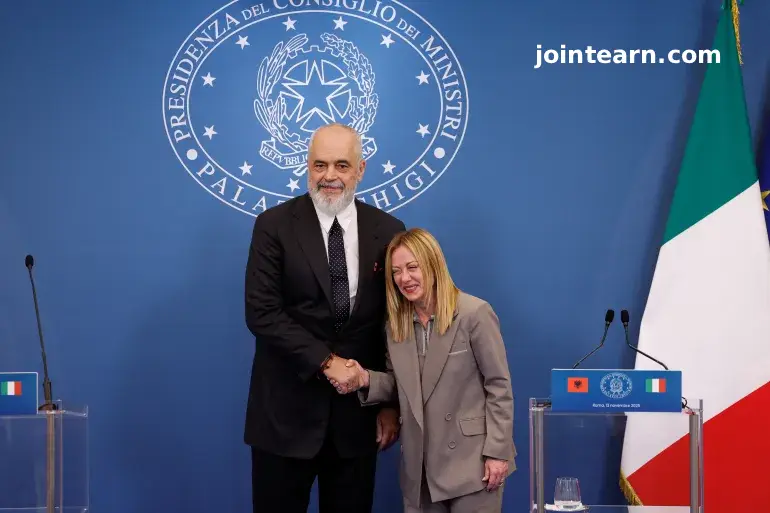
Italian Prime Minister Giorgia Meloni has reaffirmed her government’s commitment to sending migrants and asylum seekers to detention centres in Albania, despite repeated legal hurdles and criticism from human rights organizations.
Speaking at a summit in Rome alongside Albanian Prime Minister Edi Rama, Meloni emphasized that her right-wing government is “determined” to continue implementing the plan, which has sparked controversy across Italy and the European Union.
Overview of Italy-Albania Migrant Agreement
The agreement, approved by the Albanian Parliament in February 2024, allows Albania to hold up to 3,000 migrants and asylum seekers at two Italian-run processing centres near the port of Shengjin.
Key features of the agreement include:
- Migrants held for approximately one month before returning or continuing asylum procedures.
- Up to 36,000 migrants annually could be processed over a five-year period.
- Initial screening conducted on rescue ships, with further evaluation in Albania.
- Centres operated under Italian law with Italian staff and security.
- Italian judges adjudicate immigration cases remotely via video from Rome.
Despite these arrangements, the plan has faced intense opposition from human rights groups, with the International Rescue Committee calling it “dehumanising” and Amnesty International labeling it “illegal and unworkable.”
Legal Challenges and EU Scrutiny
From the outset, Meloni’s deportation plan has been hampered by Italian courts. Judges have repeatedly blocked deportations, citing that the migrants’ home countries—such as Bangladesh and Egypt—cannot be deemed safe for fast-track repatriation.
In August 2025, the European Court of Justice (ECJ) upheld these rulings, ruling that asylum applicants cannot undergo expedited returns if their origin countries are unsafe. The ECJ also stressed that Italy must adhere to strict legal standards when designating “safe countries” and ensure applicants have the right to challenge the designation.
Consequently, the detention facilities in Albania have remained largely empty, and Italy’s attempts to send migrants in October 2024 and early 2025 were reversed by the courts.
Costs and Controversy
The construction of the Albanian migrant centres has also drawn criticism for its high costs, reportedly seven times higher than equivalent facilities in Italy.
Meanwhile, Italy has seen 36,557 migrant arrivals as of August 2025—slightly higher than 2024, but far below the 89,165 recorded in 2023. These figures underscore the ongoing pressure on Italy’s immigration system and the government’s motivation to implement offshore processing.
Meloni’s Determination and Future Plans
Despite these challenges, Meloni insists that her government will continue its efforts, aligning the project with the EU migration and asylum pact slated to take effect in 2026. She stated:
“When the migration and asylum pact comes into effect, the centres will operate exactly as they should have from the beginning.”
Her government remains committed to sending migrants to Albania while ensuring the operation complies with Italian law and EU regulations, although judicial and human rights obstacles continue to hinder full implementation.
Key Takeaways
- Italy plans to process asylum seekers in Albanian centres, despite legal and human rights opposition.
- The European Court of Justice has blocked fast-track deportations to countries deemed unsafe.
- Migrant facilities in Albania remain largely empty, and construction costs are controversial.
- PM Meloni insists the plan will proceed under the new EU migration and asylum framework expected in 2026.


Leave a Reply